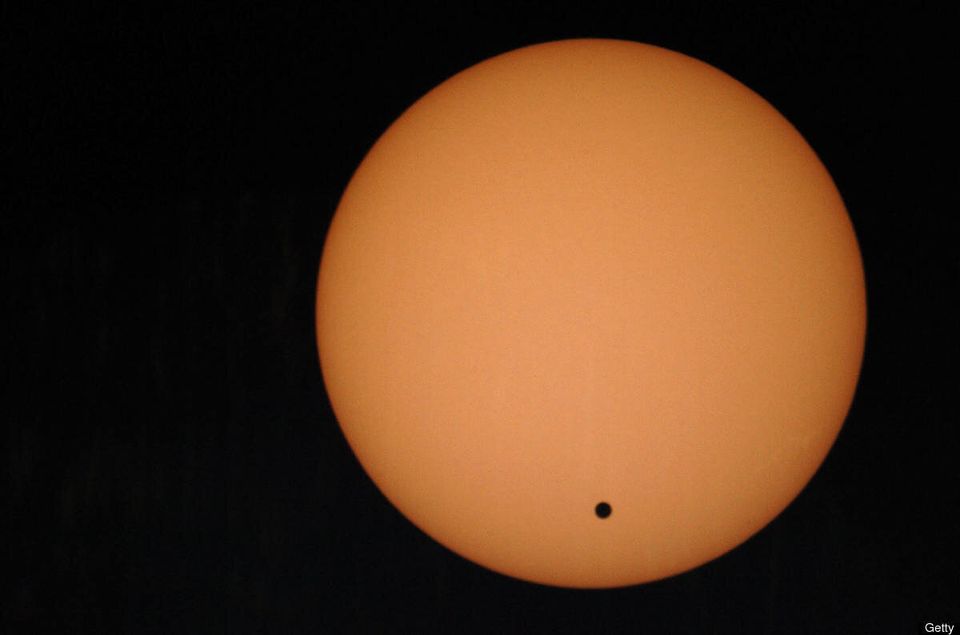A small, black dot passing across the face of the sun next week will be watched with interest, wonder and excitement by experts and amateurs around the world.
The event on Tuesday and Wednesday will be the last opportunity for anyone this century to witness the transit of Venus.
The dot is our closest planetary neighbour, moving between the earth and the sun.
For amateur skywatchers viewing projected images of the phenomenon with their telescopes, it will be something to marvel at and remember. But it will also provide valuable data for professional astronomers and planetary scientists studying worlds orbiting distant stars.
Venus transits occur in repeating pairs. The last was seen in 2004 and the next two will not be until 2117 and 2125. The previous transit to the one in 2004 was on December 6 1882.
This year's transit will last slightly under seven hours but only the final hour or so will be visible in the UK at dawn on Wednesday June 6.
The transit starts at 11.04pm on Tuesday, after sunset in the UK. The planet will take a curved path across the northern part of the sun, reaching a half-way point at about 2.30am.
Venus will then begin to move away from the sun at about 5.37am on Wednesday. Since the sun will not rise until about 4.50am, only a short period of time is available for transit watching in the UK and a good view requires an unobstructed horizon.
During the transit Venus is visible as a dark disc covering 1/32nd of the sun's surface and blocking out about 1% of its light.
It will just be large enough to be visible to someone with normal eyesight unaided. But experts have warned members of the public not to look directly at the sun without special eclipse glasses, and absolutely not to view it through binoculars or a telescope. To do so risks serious injury or blindness.
The safest way to view the transit is by projecting the sun's rays through a small telescope or pair of binoculars onto a piece of white card.
Alternatively, it can be watched in real-time on a laptop, via the US space agency Nasa's live webcast (sunearthday.gsfc.nasa.gov/transitofvenus/).
The Royal Astronomical Society also has an online facility for watching the event live, as well as showing the locations of 15 public viewing events in the UK (www.ras.org.uk/education-and-careers/for-everyone/125)
A unique historical perspective is offered by the Royal Society Venus transit website (royalsociety.org/exhibitions/transit-venus) with letters, papers, diagrams, paintings and interactive maps.
Venus transits in the 18th century marked a landmark in astronomy, the first attempt to measure the distance between the earth and the sun.
In 1761 and 1769 expeditions were sent across the globe to observe and time the transit from different points of the earth. Famously, Captain James Cook visited Tahiti to view the transit from a place still known as Point Venus.
From the results, scientists calculated the Astronomical Unit, the earth-sun distance, to be 153 million kilometres. They were almost right; the correct figure of 149.59 million kilometres was obtained from the following century's transits in 1874 and 1882.
The transit of Venus once again provides an opportunity for ground-breaking science by astronomers interested in worlds orbiting far-away stars.
In the past few years the study of "exoplanets" has been revolutionised by transits. The tiny dimming of light as a planet passes in front of a star can provide surprising amounts of information about an exoworld's size and orbit.
Future generations of space telescopes will have the ability to spot minute changes in starlight shining through a transiting planet's atmosphere. This will provide valuable clues about atmospheric composition and surface conditions, and may even reveal evidence of life.
The transit of Venus offers astronomers the chance to "test run" such techniques.
Hubble astronomers are planning to study the transit by turning the space telescope towards the moon. Aiming the sensitive machine directly at the sun would seriously damage it, so instead the moon will be used as a giant mirror. The transit will be viewed indirectly as the sun's rays bounce off the lunar surface.
Watching Venus transit the sun is informative to scientists but it can also be emotional.
"It's the only time you get to see with your own eyes the real size of a planet in relation to the size of the sun," said Robin Scagell, vice-president of the Society for Popular Astronomy.
"We're used to graphic illustrations showing planets like billiard balls and the sun the size of a football. The Venus transit gives you a real feel of the true scale of the solar system and the movement of the planets."
